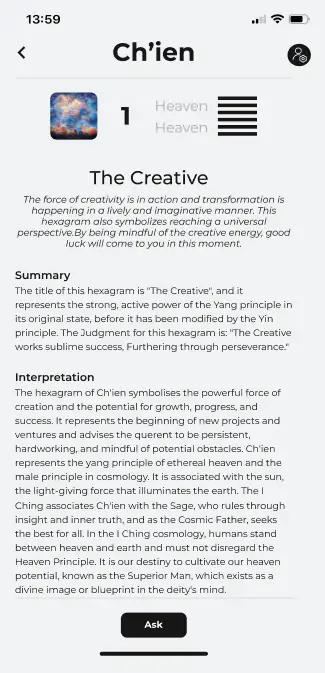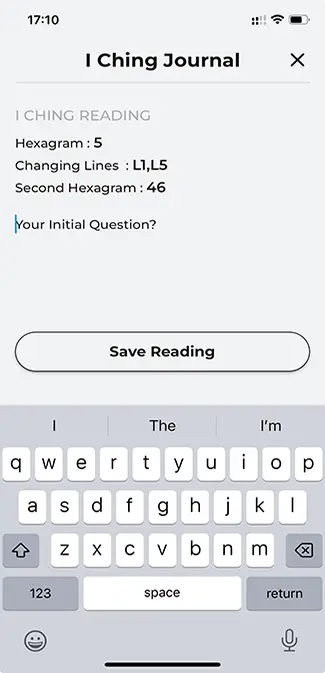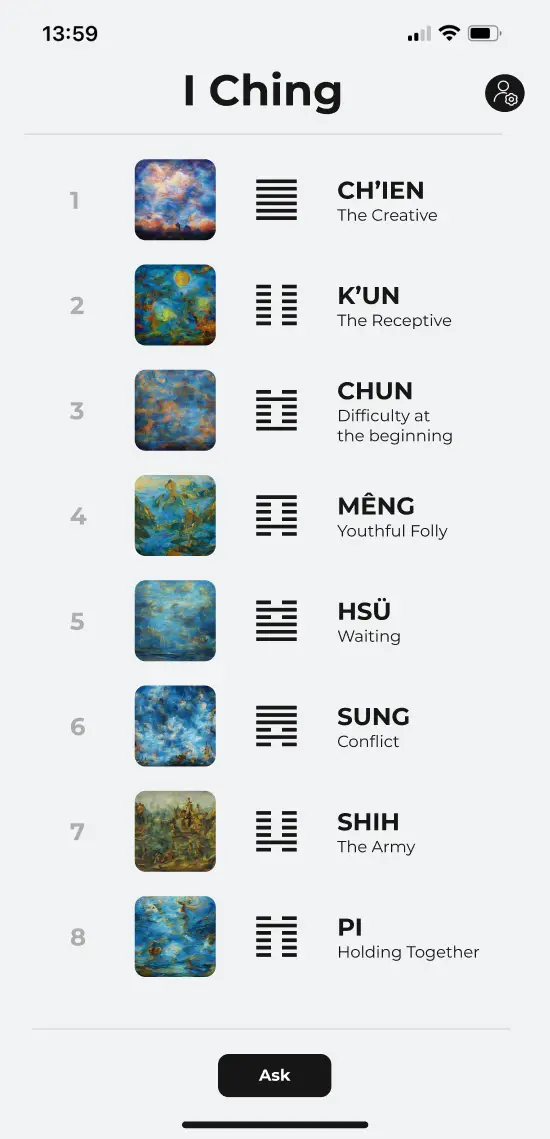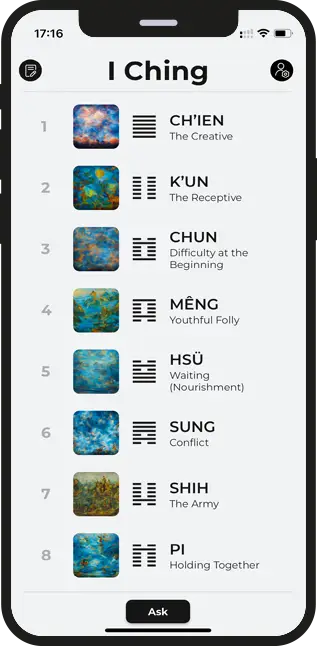
Wind
Mountain
Hexagram 53 - Gradual Progress - CHIEN
Allowing time and space to unfold can be a powerful tool for achieving progress. The I Ching suggests that those who persevere with patience and steadfastness are the ones who make continuous progress.
Summary
The central theme of hexagram 53 is slow and steady progress. The key takeaways from the judgment and image are that success comes from consistent and persistent effort and that one should avoid impulsive actions.
Interpretation
To achieve lasting progress in life, it is crucial to maintain a steady and consistent effort rather than seeking immediate results. The hexagram 53, "Development," reminds us to be patient and persistent in the face of obstacles and to avoid impulsiveness. The image of a tree growing on a mountaintop illustrates the importance of establishing a proper foundation before attempting to grow too quickly. By gradually developing ourselves, we can attain a higher level of insight and adaptability that will allow us to navigate any challenge that comes our way.
The hexagram also emphasises the need for flexibility and adaptability. Life constantly changes, and we must be open to new circumstances and adjust our approach accordingly. In doing so, we can gradually progress towards our goals while remaining centred and grounded in the present moment. The sage advice from hexagram 53 is to remain steadfast and committed to our principles, even in adversity. The image of the wild goose, which remains faithful to its mate throughout its lifetime, symbolises perseverance and fidelity. By remaining true to our path, we can overcome the negative forces that threaten to pull us off centre balance. This requires us to stay rooted in our inner selves and resist the temptation to react impulsively to external events. Teaches us that progress and change are slow, organic processes that require perseverance and fidelity. By maintaining a steady and patient approach, we can overcome the challenges that come our way and achieve lasting success.
Sage Advice
Cultivate a sense of inner peace and contentment by letting go of attachment. The judgment for hexagram 53 states that "To be able to let go of attachment brings inner peace and contentment. The more one can let go, the greater the inner peace and contentment." This means that true inner peace and contentment come from letting go of attachment to material possessions or external circumstances. The advice provided by the I Ching is to focus on cultivating inner peace and happiness by letting go of attachment.
Maintain a balance between humility and self-assertion, and avoid becoming passive or aggressive. The judgment for hexagram 53 states that "The proper balance of humility and self-assertion ensures success. Too much humility leads to passivity, while too much self-assertion leads to aggression." This means one should strive to balance being humble and assertive and avoid becoming too passive or aggressive. The advice provided by the I Ching is to find a balance between humility and self-assertion and to avoid becoming too passive or aggressive in one's efforts.
Line 1
The image of a wild goose gradually drawing near the shore represents the initial stages of self-development, where doubt and fear can easily take hold. It is natural to want quick progress and to attach ourselves to solutions or success formulas that promise quick results, but this can lead us astray. The I Ching advises us to remain patient and detached and to wait with neutrality and acceptance. We must not allow doubt and fear to sway us from what is correct and instead persevere in our efforts, even if progress initially seems slow. The wild goose symbolises perseverance and faithfulness, reminding us that progress comes gradually, like the goose's slow journey to the shore. The first line of this hexagram counsels us to be patient and steadfast in the face of doubt and fear and to trust in the slow but steady progress of self-development.
Line 2
Reminds us that a time of peace and harmony can lead to complacency and selfishness. When we experience a lull in danger or adversity, we may forget to be careful and attentive to our inner attitudes and behaviours. We may become careless and forget our duty to others, especially those still struggling. However, this line also advises us to be mindful of our thoughts and emotions, especially those that give rise to doubt and despair. The I Ching warns us against indulging in "bad nourishment" - ideas that harm our inner serenity and disturb our emotional balance. Instead, we should focus on thinking of others and sharing our good fortune with them. Sharing our good luck with others means material possessions and the wisdom and insight we have gained through our experiences. It means being conscientious and responsible, not only for our well-being but also for those around us. We must remember our duty to help others and rescue them from their troubles, even after we have attained a measure of security for ourselves. It reminds us that success and good fortune should not make us selfish and complacent but instead inspire us to be more compassionate, generous, and mindful of others.
Line 3
Warns against impulsive action under challenging situations. Instead of immediately responding with force or resistance, remaining still and disengaging from the situation is advised. A solution may reveal itself by allowing time to pass and not interfering. It is important to remember that every challenge is an opportunity for growth and self-improvement. Resisting the natural flow of events or striving against them will only lead to harm. The advice of the I Ching is to stay balanced and centred in the face of difficulty, allowing a true and lasting resolution to be found.
Line 4
Yielding to what is happening is crucial in facing difficulties rather than resisting fate. The image of the flat branch in the fourth line of hexagram 53 represents the importance of nonresistance in navigating challenging situations. Just as the wild goose rests on whatever surface is available, even if it is not ideal, we should also yield and adapt to the circumstances to find a way past the difficulty. Avoiding impatience, ambition, fear, and despair is essential, as these emotions can lead us to resist what is happening and cause further harm. Instead, we should embrace nonresistance and trust in the natural flow of events, knowing that a more beneficial time will come.
Line 5
Reminds us that periods of isolation are often a necessary part of the journey towards self-development. During these times, others may misunderstand our lack of action or reaction, and we may feel frustrated by our inability to explain ourselves. However, remaining patient and persevering through these difficult times is essential, trusting that following the path of goodness and truth will ultimately lead to success. The image of the wild goose drawing near the summit suggests that, like the goose, we must continue to climb higher and higher, even when the way is steep, and the progress seems slow. Ultimately, we will reach new heights and achieve great success by remaining steadfast in our dedication to self-improvement.
Line 6
Speaks to the idea that when we remain true to what is correct and maintain our independence, we open ourselves up to the power of the Creative to guide us in everything. By staying committed to our path and not getting caught up in past wrongs or presumptions, we free ourselves to respond to fundamental changes in the present. This can lead to great success and serve as an inspiring example to others. The image of the wild goose drawing near the cloud heights symbolises the ultimate attainment of our goals through perseverance and fidelity to our principles.








